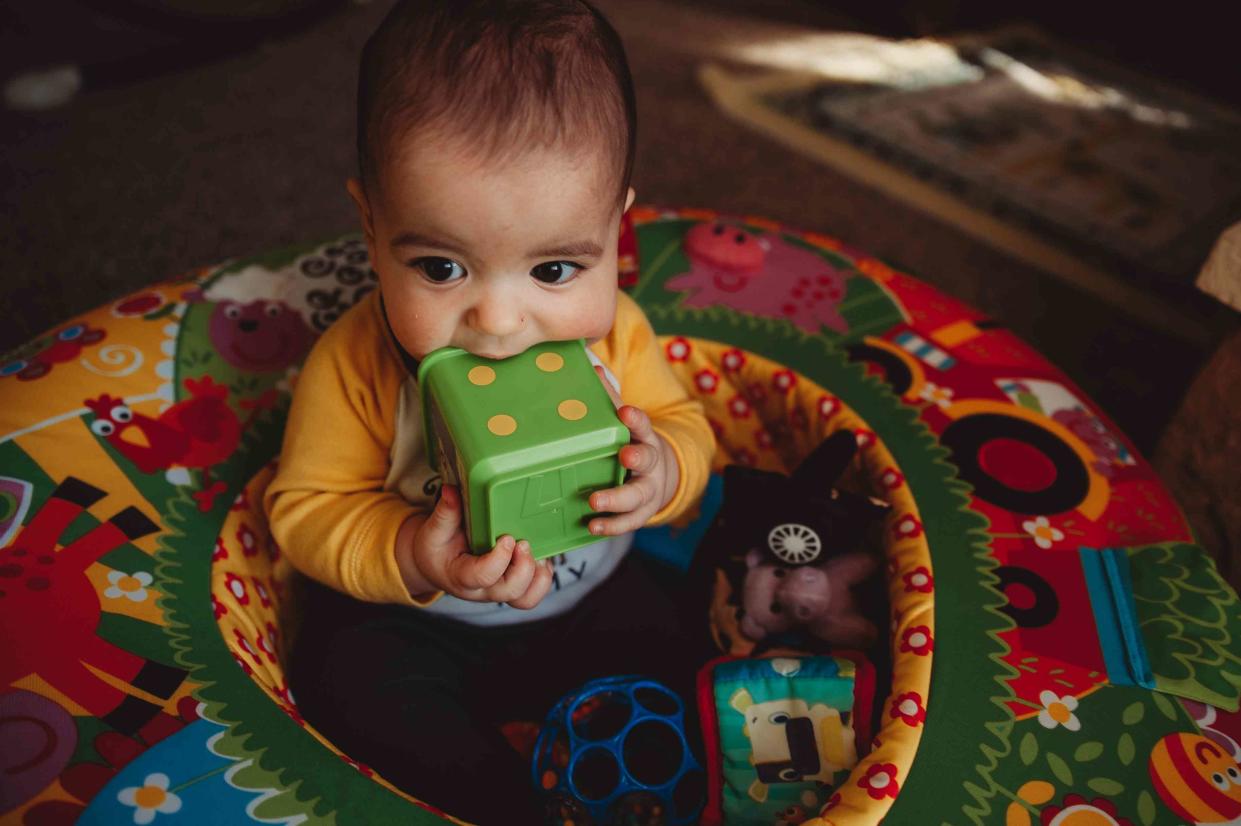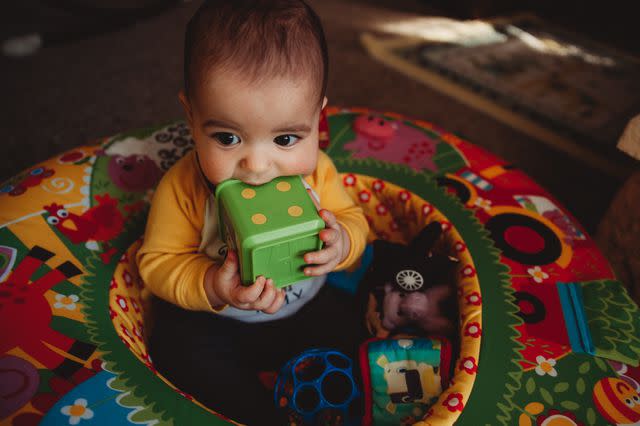Can Teething Cause a Fever in Babies?

Jill Lehmann Photography / Getty Images
Medically reviewed by Lyndsey Garbi, MD
Fever in babies is often attributed to teething, but there is no evidence that the two are connected. A temperature over 100.4 degrees F (38 degrees C) likely means your child has an illness, even if they also happen to be teething.
This article will discuss symptoms of teething and how to soothe discomfort, how to tell if your child is sick, ways to manage a fever, and when to see a healthcare provider.

Jill Lehmann Photography / Getty Images
Does Teething Cause Fever?
Despite the myth, teething does not cause fever. It can be tempting to attribute fever to teething, but doing so may mean missing an illness such as an ear infection, urinary tract infection, meningitis, or another bacterial or viral infection.
Teething also does not cause diarrhea or runny nose, and typically does not cause a lot of crying. When symptoms such as these are blamed on teething, a diagnosis and needed treatment could be delayed.
Fever may happen while a baby is teething, because the development of fevers typically begins around when babies begin to start teething. Between 6 and 12 months of age, babies lose the antibodies they gained from their birthing parent. It's also developmentally appropriate for them to chew on everything, increasing their exposure to illness.
When Do Babies Start Teething?
When babies are born, they have 20 teeth beneath the gums. Some babies are born with one or more teeth already grown in.
Each baby is different. Teething can begin as early as 3 months old, but most of the time the first tooth pokes through between 4 and 7 months old.
It's not unusual for babies who are 10 to 12 months to not have teeth yet, and it is not a reason to worry.
While not a guarantee, the two bottom front teeth are usually the first to appear, followed by the four front upper teeth about four to eight weeks later. About a month after that, the two teeth flanking the bottom front teeth typically come in, followed by the first molars, then the eyeteeth.
Most children have all of their primary teeth by the time they turn 3 years old. Talk to your healthcare provider if your child's teeth are coming in much more slowly than this.
Teething Symptoms
Sometimes, the only symptom of teething is a tooth appearing. Teething does not always cause pain or discomfort for the baby.
When a baby is teething, they may experience symptoms such as:
Minor discomfort
Crankiness or irritability
A need to chew on things
Soreness, swelling, and redness on the gum where the tooth is emerging
Redness on one or both cheeks
Not sleeping well
A slight increase in temperature (100.4 F/38 C or less)
How to Tell If Your Child Is Sick
A body temperature of 100.4 degrees F or higher is considered a fever and usually indicates an infection or illness.
The degree of the fever does not always correlate with the seriousness of the illness. Sometimes, minor illnesses can cause high fevers, and serious illnesses may not cause a high fever. It's more important to pay attention to how your child is feeling and behaving and to look for signs of the underlying illness than focusing on the thermometer number.
In addition to symptoms related to the underlying illness (such as earache for an ear infection), a child with a fever may also have symptoms such as:
Feeling hot (or cool) to the touch
Feeling unwell
Irritability, fussiness, or crying
Shivering, goosebumps, or tremors
Grogginess or more sleepy than usual
Vomiting
Refusing to drink or being thirsty
Pain
Sweating
Looking flushed or pale
Way to Soothe Sore Gums
If your baby feels discomfort while teething, there are things that can help, and things to avoid.
Do not use:
Prescription or over-the-counter (OTC) drugs
Homeopathic or "all-natural" drugs, such as "teething tablets"
Numbing medications, such as such as Anbesol, Baby Orajel, Cepacol, Chloraseptic, HurriCaine, Orabase, Orajel, and Topex
"Teething jewelry," such as amber necklaces and bracelets
Frozen teething rings, or objects that are too hard
Teething rings or other objects without supervision
Substances placed or rubbed on the gum, such as aspirin or alcohol
The Food and Drug Administration (FDA) indicates these can lead to harm, or even death.
Instead, try some of these safer methods to help your baby feel better.
Gum Massages
Wash your hands, and gently rub or massage your baby's irritated gums with your finger, a moist gauze pad, or a clean, wet cloth. Chilling the wet cloth in the fridge first can also help.
Teething Rings and Toys
Giving your baby a teething ring or teething toy to chew on allows them to massage their own gums safely. Some teething rings can be chilled in the fridge (the package should indicate how long to chill them), but never freeze them as this could damage their gums.
To avoid strangulation, never tie a teething ring (or anything else) around your child's neck. Only use a teething ring when the child is directly supervised.
Choose ones that are made of solid, firm rubber. Avoid ones that have liquid in them because they could leak or break. Don't boil them to sterilize them, which can damage the plastic and leak chemicals.
Make sure the item is too big to swallow, and can't break into pieces, to avoid choking hazards.
Be aware of what they are made of, and buy from reputable companies. Even objects that are labeled for teething can contain harmful components, such as lead. This includes "natural" and homeopathic teethers.
Washcloths
Washcloths are handy to have around when your baby is teething. You can:
Use a clean, wet washcloth to massage your baby's gums.
Give your baby a clean, chilled, wet washcloth to gnaw on.
Gently wipe your baby's face often, to prevent excess drool from irritating their skin.
Foods
If your baby is 6 months or older and able to chew solid food, you can try giving them chilled foods, such as soft fruits like banana or melon. Avoid giving them hard foods, such as raw carrots, as these can be choking hazards.
Baby rusks often contain sugar, and may not be as good an option as they can cause tooth decay.
Always supervise your baby when they have food to avoid the risk of choking.
Comforting
If your baby is irritable, they may need some extra comforting. Distraction can also help. Try drawing your baby's attention by playing with them or showing them something interesting.
Ibuprofen or Acetaminophen
If other measures aren't helping to ease your baby's discomfort, and your baby is over 6 months old, you can talk to your healthcare provider about giving infant pain-relieving medication like Advil/Motrin (ibuprofen) or Tylenol (acetaminophen).
This medication should be used short-term (about a day) and dosed appropriately. Talk to your healthcare provider or pharmacist about how much and how often to administer it.
Never give aspirin to children under the age of 16 years.
How to Treat a Baby’s Fever at Home
Fevers don't always need to be medicated. If your child has a fever but isn't uncomfortable, or if they can feel better using nonmedicinal measures, you don't necessarily need to use medication to reduce the fever.
If medication is warranted, talk to your healthcare provider about giving them fever-reducing medications like acetaminophen or ibuprofen. It can take 90 minutes to two hours for the temperature to come down after giving medication, and the fever may return.
Even if the temperature is still high, don't give more than the recommended dosage or give it to your child more often than the directions indicate.
If your baby is under 6 months, offer more breastfeeding/chestfeeding opportunities (if you are formula feeding, offer the usual amount of formula).
If your baby is older than 6 months, keep offering breast milk or formula, and you can offer water or oral rehydration solutions.
Offer small amounts of fluids often to help keep them hydrated (if they are old enough, you can offer water, watered-down apple juice, Popsicles, etc.).
If your child is hungry, feed them, but it's OK if they don't want to eat as long as they stay hydrated.
Replace heavy blankets with a sheet (if they are old enough to sleep with bedding).
Dress your child in light clothing, such as a diaper or underwear and a light shirt, to allow heat to escape their body.
Don't let your child get cold enough to shiver; this can raise body temperature (add clothing one layer at a time until the shivering stops).
Wipe your child's forehead with a lukewarm (not cold) wet cloth or sponge.
Follow your healthcare provider's instructions regarding treatment for the underlying illness.
Watch for signs their illness is getting worse.
Don't give your child a cold bath or shower, as this can make them too cold and/or cause them to shiver.
Never wipe or bathe your child with alcohol. It is a poison and can be absorbed through the skin.
When to Worry About a Fever in Babies
See a healthcare provider right away if your child is younger than 3 months old or is immunocompromised and has a temperature above 100.4 degrees F, even if they have no other symptoms.
If your child is older than 3 months old and not immunocompromised, see a healthcare provider if they have a fever and any of the following:
A stiff neck
Light hurts their eyes
A rash
Problems with breathing
Vomiting or diarrhea, especially if not drinking much
Pain that doesn't get better with pain relief
Fever that lasts more than two days and doesn't have an obvious cause
Febrile seizure
Feeling increasingly unwell
Excessive crankiness, fussiness, or irritability
Persistent wheezing or coughing
Excessive sleepiness, or is lethargic or unresponsive
Headache, earache, sore throat, or other signs of illness you are concerned about
Fever that lasts three to days with no improvement
When to See a Healthcare Provider
Teething doesn't usually need medical attention. Most of the time, symptoms can be managed at home.
Talk to your healthcare provider if your child has:
Symptoms that are severe or last longer than a couple of days
A small jaw or abnormalities of the mouth or jaw (such as a cleft palate)
Visible signs of tooth decay
No teeth by 18 months
Permanent teeth coming in before the primary teeth fall out (creating a double row of teeth)
A facial injury that has damaged a tooth or gums
You have any concerns
Summary
Despite the popular myth, teething does not cause fevers. A temperature of 100.4 degrees F or higher typically indicates an illness or infection, not teething. Not all babies have symptoms while teething, but teething symptoms may include irritability, a need to chew, increased drooling, sore gums, and red cheeks.
In addition to symptoms related to the underlying illness, children with a fever may also have symptoms such as feeling unwell, grogginess, vomiting, pain, or looking flushed or pale. Teething discomfort can be eased by massaging your baby's gums, letting them chew (on teething rings, washcloths, or soft foods), or pain medication if necessary.
If your child has a fever, dress them lightly, offer small drinks often, and give fever-reducing medicine if necessary. Contact your healthcare provider if the fever lasts longer than a couple days.

